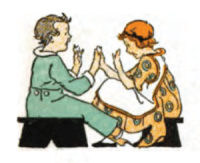The Farmer in the Dell
| "The Farmer in the Dell" | |
|---|---|
| Roud #6306 | |
| Song | |
| Written | Germany |
| Published | 1820 |
| Form | Nursery rhyme |
| Writer | Traditional |
| Language | English |
"The Farmer in the Dell" is a singing game, nursery rhyme and children's song. It probably originated in Germany, and was brought to North America by immigrants.[1] From there it spread to many other nations and is popular in a number of languages. It has a Roud Folk Song Index number of 6306.
Lyrics
Lyrics vary even within the same country. The following is a common version in the United States:
- The farmer in the dell
- The farmer in the dell
- Heigh-ho,[2] the derry-o
- The farmer in the dell
- The farmer takes a wife (2×)
- Heigh-ho, the derry-o…
- The farmer takes a wife
- The wife takes the child (2×)
- Heigh-ho, the derry-o…
- The wife takes the child
- The child takes the nurse (2×)
- Heigh-ho, the derry-o…
- The child takes the nurse
- The nurse takes the cow (2×)
- Heigh-ho, the derry-o…
- The nurse takes the cow
- The cow takes the dog (2×)
- Heigh-ho, the derry-o…
- The cow takes the dog
- The dog takes the cat (2×)
- Heigh-ho, the derry-o…
- The dog takes the cat
- The cat takes the mouse (or rat) (2×)
- Heigh-ho, the derry-o…
- The cat takes the mouse
- The mouse (or rat) takes the cheese (2×)
- Heigh-ho, the derry-o…
- The mouse (or rat) takes the cheese
- The cheese stands alone (2×)
- Heigh-ho, the derry-o…
- The cheese stands alone
The UK variant has the nurse and the dog, it ends by patting the dog.
Origins and dissemination
The rhyme is first recorded in Germany in 1826, as "Es fuhr ein Bau'r ins Holz," and was more clearly a courtship game with a farmer choosing a wife, then in turn the selecting of a child, maid, and serving man, who leaves the maid after kissing.[1] This was probably taken to North America by German immigrants, where it next surfaced in New York in 1883 much in its modern form and using a melody similar to "A Hunting We Will Go".[1] From here it seems to have been adopted throughout the United States, Canada (noted from 1893), the Netherlands (1894) and Great Britain; it is first found in Scotland in 1898 and England from 1909. In the early twentieth century it was evident as wide as France ("Le fermier dans son pré"), Sweden ("En bonde i vår by"), Australia, and South Africa.[1]
Variations
Like most children's songs, there are geographic variations.
In the United Kingdom the first line is frequently changed to "The Farmer's in his den". The rhyme progresses through the farmer being in the dell/his den, his desire for a wife, hers for a child, its for a nurse, a dog, ending with a bone, which is then vigorously patted: "we all pat the bone".[1] The 'Hi-Ho, the derry-o' is variously replaced with "Ee-i, tiddly-i" in London, 'Ee-i, adio', 'Ee-i, andio' or 'Ee-i, entio', (in Northern England), and 'Ee-i, ee-i' (for instance in the West Country).[1]
The Romanian version is "Țăranul e pe câmp" (The farmer is on the field) but the hey-o is replaced with "Ura, drăguţa mea" (Hooray, my sweet heart) and the last verses are – the child has a nurse, the nurse has a cat, the cat catches a mouse, the mouse eats a cheese, the cheese was in a cask, the cask is in the garbage, the farmer to choose.
There is also a Thai version to the same tune but with a slightly different story. The three verses roughly translate to "Why does the frog have a stomach ache? Why does the frog have a stomach ache? Because he has been eating wet rice. Why is the rice wet? Why is the rice wet? Because it has been raining. Why has it been raining? Why has it been raining? Because the frog has been croaking."
The song was published as an illustrated children's book by David R. Godine, Publisher in 2004.
Game
The players form a circle holding hands around one who is designated as the farmer, singing the first verse while moving around. When the verse is over they stop and the farmer makes his choice of a wife (sometimes without looking). The wife joins him in the center for her verse and so through the verses until either the cheese or dog is selected or only one person is left to become the last character. They usually become the farmer for the next round.[1]
In popular culture
- Omar Little, a notorious stick-up man on the HBO series The Wire, often announces his arrival by whistling the song.
References
- ↑ 1.0 1.1 1.2 1.3 1.4 1.5 1.6 I. Opie and P. Opie, The Singing Game (Oxford: Oxford University Press, 1985), pp. 183-9.
- ↑ William Wells Newell (1883). William Wells Newell, ed. Games and songs of American children, collected and compared by W.W. Newell. Harper and Brothers. pp. 129–30. Retrieved 2 August 2012.
